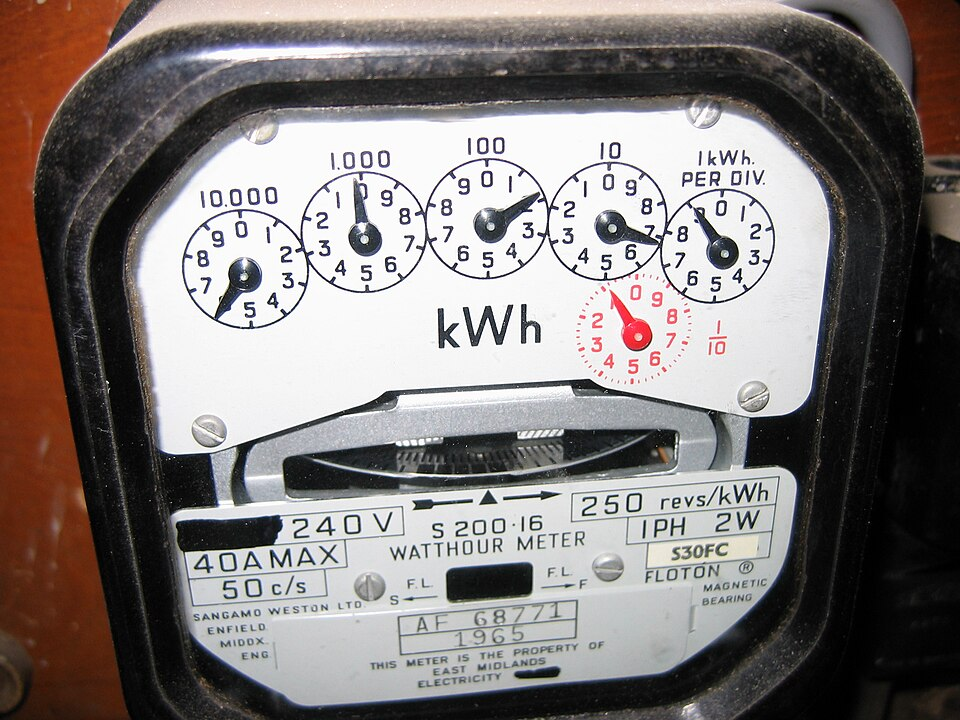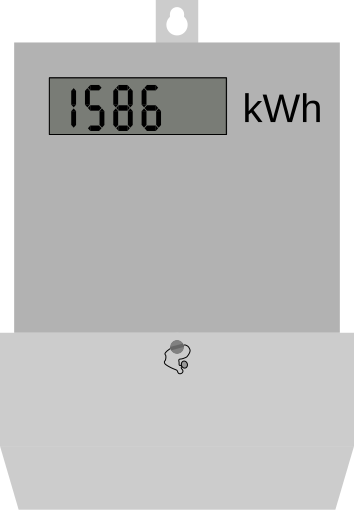OCR Specification focus:
‘Calculate energy costs from usage in kWh and tariff rates.’
Understanding how to calculate the cost of electrical energy is essential for analysing household energy bills, comparing appliances, and appreciating the economic impact of efficient energy use.
Understanding Electrical Energy Costs
Electrical devices convert electrical energy into other useful forms such as heat, light, or motion. The cost of energy depends on both the amount of electrical energy consumed and the rate charged by the electricity supplier. Consumers are billed based on energy usage over time, measured in kilowatt-hours (kWh), multiplied by the supplier’s tariff rate.
The Kilowatt-hour and Energy Consumption
The kilowatt-hour (kWh) is the standard unit used by energy companies to measure electrical energy consumption. It provides a practical way to express the energy used by appliances over time.

Close-up of a mechanical kWh meter showing the analogue dials read to obtain total energy used. Readings (in kWh) multiplied by the tariff rate determine the cost of electricity used. Image shows dial direction alternation, an authentic feature of older meters; extra mechanical detail is not required by the syllabus. Source.
EQUATION
—-----------------------------------------------------------------
Energy Transferred (W) = V I t
V = Potential difference (volts, V)
I = Current (amperes, A)
t = Time (seconds, s)
—-----------------------------------------------------------------
While this equation gives energy in joules (J), energy use for domestic and industrial billing is expressed in kilowatt-hours, where:
1 kWh = 1000 W × 3600 s = 3.6 × 10⁶ J.
This conversion helps make large energy values more manageable for everyday use and billing.
Relating Energy to Power and Time
The power rating of an appliance indicates the rate at which it uses electrical energy. For example, a 2 kW heater consumes 2 kilojoules of electrical energy every second. When operated for a period of time, the total energy consumed can be calculated using:
EQUATION
—-----------------------------------------------------------------
Energy (E) = Power (P) × Time (t)
E = Energy used (kilowatt-hours, kWh)
P = Power rating of the device (kilowatts, kW)
t = Time of operation (hours, h)
—-----------------------------------------------------------------
This relationship allows energy usage to be estimated for any appliance once its power rating and operating duration are known.
Tariff Rates and Cost Calculations
Electricity suppliers set a tariff rate, which is the cost per unit of energy (pence per kWh). To determine how much a device or household pays, multiply the energy used by this tariff rate.
EQUATION
—-----------------------------------------------------------------
Cost (C) = Energy Used (E) × Tariff Rate (R)
C = Total cost (pounds or pence, £ or p)
E = Energy used (kilowatt-hours, kWh)
R = Cost per kilowatt-hour (p/kWh or £/kWh)
—-----------------------------------------------------------------
This simple equation is used across domestic and industrial contexts to calculate energy expenses and allows consumers to budget effectively.
Components of a Typical Electricity Bill
An electricity bill generally includes several key elements:
Standing charge: A fixed daily cost for maintaining the supply connection, metering, and infrastructure.
Unit rate: The tariff rate charged per kWh of energy consumed.
Total consumption: The sum of all electrical energy used during the billing period, often recorded from a meter reading.
Taxes or levies: Additional costs such as VAT or environmental charges.
By combining the unit rate with the total energy used, plus any fixed standing charges, the final cost of electricity can be determined.
Variable and Tiered Tariff Systems
Electricity tariffs may vary depending on the supplier or the time of day. Two common systems are:
Flat-rate tariffs: A single rate per kWh regardless of when energy is used.
Time-of-use tariffs: Different rates depending on demand periods, such as peak and off-peak times (e.g. Economy 7).
Understanding tariff structures allows consumers to adjust usage habits, operating high-energy devices during cheaper periods to save money.
Monitoring and Managing Energy Use
Energy meters and smart meters help track energy consumption in real-time, offering detailed insights into when and how much electricity is used.

Smart meter with a digital LCD display used to record electricity consumption for billing in kWh. Such meters support tariffed billing by timestamping usage, enabling time-of-use pricing where applicable. Diagram is simplified for clarity and omits communications hardware not required by the syllabus. Source.
This information encourages efficiency by identifying waste and prompting behavioural changes such as:
Switching off devices when not in use.
Using energy-efficient appliances with lower power ratings.
Scheduling energy-intensive activities during low-tariff periods.
Such practices not only reduce costs but also decrease environmental impact through lower energy demand.
Factors Affecting Energy Cost Calculations
When calculating energy costs, several factors should be considered to ensure accuracy:
Appliance efficiency: Not all input electrical energy is converted into useful output; some is lost as heat or sound.
Duration of use: Longer operating times increase energy consumption linearly.
Power factor (for AC circuits): In industrial contexts, the phase difference between voltage and current can slightly alter the effective power consumption.
Changes in tariff rates: Energy providers may vary prices seasonally or based on wholesale market rates.
Accurate measurement of these variables is essential for meaningful cost comparisons and budgeting.
Efficiency and Cost Relationship
Efficiency describes how effectively an appliance converts electrical energy into useful output. An inefficient device uses more energy for the same task, resulting in higher running costs.
Efficiency: The ratio of useful energy output to total energy input, usually expressed as a percentage.
More efficient devices require less energy to perform the same function, thus reducing both operational costs and environmental impact.
The Role of Energy Cost Awareness
Awareness of how energy costs are calculated empowers consumers to make informed decisions. By understanding how power, time, and tariff rates combine to determine the total cost, users can adopt strategies to minimise unnecessary energy use. This includes choosing low-power appliances, improving insulation, and embracing renewable technologies to offset grid consumption.
Accurate cost calculation ensures fair billing, supports budgeting, and reinforces the importance of responsible energy use — aligning with both personal financial interests and wider sustainability goals.
FAQ
The tariff rate is the cost per kWh of energy consumed, while the standing charge is a fixed daily fee for maintaining the connection and metering.
Even if no electricity is used, the standing charge still applies. This ensures energy companies recover costs for grid maintenance, customer service, and infrastructure.
Smart meters record real-time electricity usage and transmit data securely via a wireless communication network known as the Wide Area Network (WAN).
They communicate through a Home Area Network (HAN) to an in-home display, showing consumption and cost updates.
This automatic transmission removes the need for manual meter readings and enables accurate, time-based billing.
Economy 7 tariffs offer cheaper electricity rates during off-peak night hours and higher rates during the day. They are designed to encourage energy use when demand is lower.
To benefit, households can:
Run high-power appliances (e.g. washing machines, dishwashers) at night.
Use storage heaters that charge overnight and release heat during the day.
This tariff reduces costs only if a significant proportion of energy use occurs during cheaper hours.
The joule is too small a unit for practical energy billing—1 kWh equals 3.6 million joules. Using kWh makes household and industrial consumption figures manageable.
It simplifies calculations and billing because appliance power ratings are in kilowatts, allowing energy use to be easily calculated by multiplying power by time in hours.
Electricity prices differ due to:
Variations in distribution costs, as maintaining rural or remote grid infrastructure is more expensive.
Regional demand and the balance of supply sources (renewables vs fossil fuels).
Supplier competition, which affects available tariffs.
These factors mean two households with identical usage can pay slightly different rates depending on their location.
Practice Questions
Question 1 (2 marks)
An electric heater has a power rating of 1.5 kW. It operates for 4 hours each day. The cost of electricity is 30 pence per kWh.
Calculate the cost of running the heater for one day.
Mark scheme:
1 mark: Correct calculation of energy used: 1.5 × 4 = 6.0 kWh
1 mark: Correct calculation of total cost: 6.0 × 30 = 180 pence or £1.80
Question 2 (5 marks)
A homeowner uses three appliances:
• a 2.0 kW kettle for 0.5 hours per day
• a 0.3 kW refrigerator running for 10 hours per day
• a 0.1 kW LED lighting system running for 6 hours per day
The electricity supplier charges 25 pence per kWh.
(a) Calculate the total energy used by the three appliances in one day.
(b) Determine the total daily cost of operating all three appliances.
(c) State one method the homeowner could use to reduce their total energy cost.
Mark scheme:
(a) Energy used by each appliance (2 marks total):
Kettle: 2.0 × 0.5 = 1.0 kWh (1 mark)
Refrigerator: 0.3 × 10 = 3.0 kWh (½ mark)
Lighting: 0.1 × 6 = 0.6 kWh (½ mark)
Total energy = 1.0 + 3.0 + 0.6 = 4.6 kWh (1 mark if all correct)
(b) Cost calculation (2 marks):
Cost = 4.6 × 25 = 115 pence or £1.15 (1 mark for method, 1 mark for correct answer)
(c) Energy reduction method (1 mark):
Any valid point such as:
• Use appliances with higher efficiency ratings.
• Turn off lights when not in use.
• Use a time-of-use tariff and operate devices during off-peak hours.

